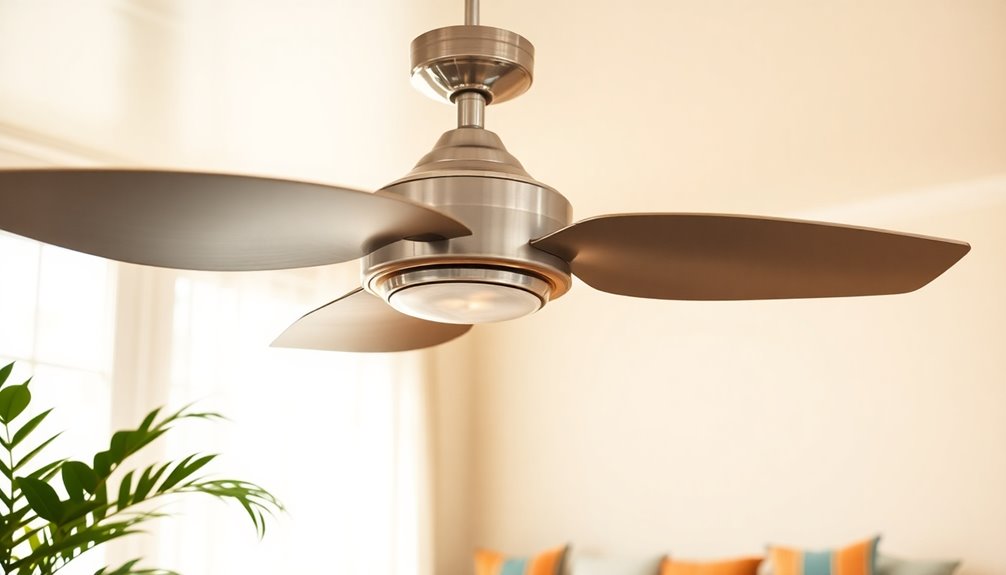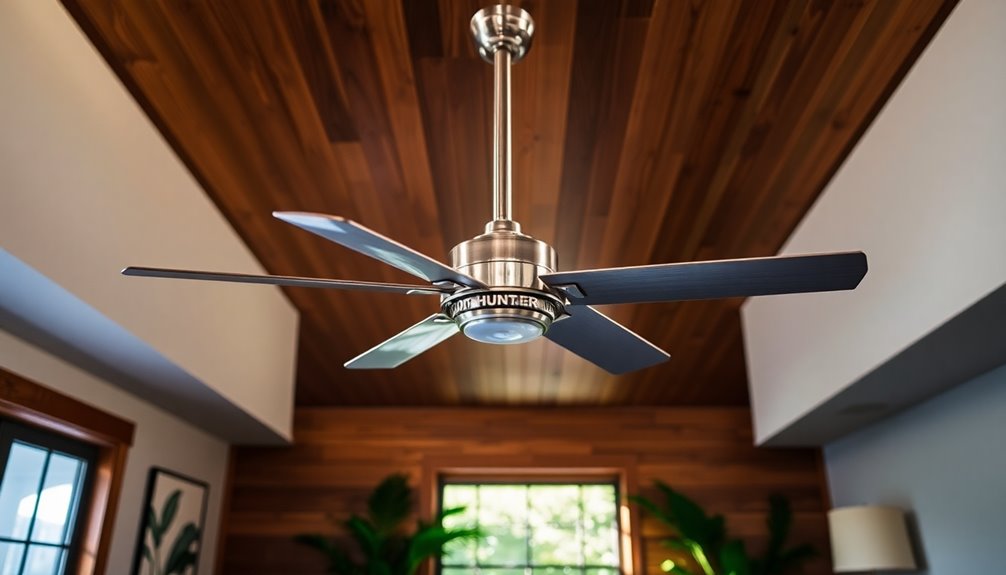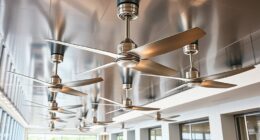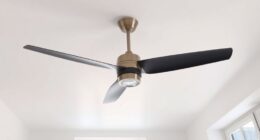If your ceiling fan's making a humming noise, it might be due to several factors. Faulty dimmers, loose components, or incorrect bulb wattage can cause this issue. Check if your dimmer switch is compatible with fan motors; incompatible ones create voltage fluctuations. Also, verify all screws and bolts are tight to prevent vibrations. Sometimes, remote control problems or worn motor parts can be the culprits, too. Regular maintenance can help keep your fan quiet. Uncovering the specific cause can lead to effective solutions that make your fan run smoothly again.
Key Takeaways
- Faulty electrical dimmers can cause voltage fluctuations, leading to humming noises in ceiling fans.
- Loose components, such as fan blades or light fixtures, may create vibrations that result in humming sounds.
- Using incorrect wattage bulbs can produce buzzing noises; ensure bulbs are compatible with the fan.
- Mechanical issues, like worn motor parts or unbalanced blades, can contribute to humming; regular maintenance is essential.
- Consider replacing incompatible dimmers with fan-specific controls to prevent unwanted humming and improve performance.
Common Causes of Humming Noise

When you hear a humming noise from your ceiling fan, it can be frustrating, but you're not alone. Several common causes might be behind that irritating sound. One major culprit is faulty electrical dimmers. If they're incompatible with your fan's speed control, they can cause voltage fluctuations that lead to the humming noise.
If your ceiling fan is remote-controlled, a weak or malfunctioning remote receiver could be the issue. You can test this by connecting the fan directly to the power source.
Additionally, loose fan blades or light fixtures can create vibrations, manifesting as humming or rattling. It's a good idea to inspect and tighten all screws to eliminate this possibility.
Another factor to take into account is the wattage of your light bulbs. Using incorrect wattage can cause buzzing sounds, so check that your bulbs are compatible with your fan model.
Finally, mechanical issues within the motor, such as worn components or an unbalanced blade assembly, might be causing the noise. Regular maintenance can help you address these concerns and restore peace to your home.
Electrical Issues and Solutions

If your ceiling fan hums, electrical issues could be the culprit.
Incompatible dimmer switches can cause voltage fluctuations, so it's crucial to verify they're designed for fan control.
Additionally, check your wiring and connections; loose or damaged components might need your immediate attention.
Dimmer Switch Compatibility
While dimmer switches can add versatility to your lighting, using one that's not designed for ceiling fans can lead to annoying humming noises. Many ceiling fans generate this humming when connected to incompatible dimmer switches, as these dimmers can cause voltage fluctuations that disrupt fan performance.
Typically, dimmer switches control light brightness by altering voltage levels, resulting in an inappropriate power supply for your fan's motor.
To eliminate the humming noise, it's best to replace those incompatible dimmer switches with standard ON/OFF switches or fan-specific speed controls. This not only quiets your fan but also guarantees it operates efficiently.
It's vital to recognize that using a dimmer switch can void warranties on some ceiling fan models, as manufacturers often advise against their use for fan speed control.
If you've switched to a compatible control method and the buzzing or humming persists, you may need to investigate further electrical issues, such as faulty wiring or a malfunctioning fan motor.
Taking these steps will help you enjoy a quieter and more efficient ceiling fan.
Wiring and Connections
Incompatible dimmer switches aren't the only culprits behind humming noises in ceiling fans. Faulty wiring connections can also be a significant issue. Loose or damaged wires create electrical resistance, which can produce that annoying humming or buzzing sound.
It's vital to inspect your wiring connections regularly, as any signs of wear can indicate a problem that needs immediate attention.
Additionally, verify that you're using the correct wattage light bulbs. Overloading your fan's electrical components with higher wattage bulbs can lead to excessive noise.
If your fan is controlled by a remote, a malfunctioning remote receiver might be causing the hum. To check, disconnect the fan from the remote and connect it directly to power.
Regular maintenance checks on your ceiling fan's electrical connections are essential. By addressing these wiring issues proactively, you can prevent annoying sounds and guarantee safe operation.
Mechanical Problems and Fixes

Humming noises from your ceiling fan can stem from various mechanical problems that are often easy to resolve. If your fan is noisy, check for loose blades or light fixtures. Tightening screws can greatly reduce vibrations, helping to silence that annoying hum.
Another common culprit is the remote receiver in remote-controlled fans. If it's weak, try connecting the fan directly to the power source; this may eliminate the noise altogether.
Also, verify that your fan's installation is correct. Missing screws or improperly mounted brackets can amplify sounds, so double-check that everything is securely fitted.
Electrical issues can also lead to a noisy fan. Worn motor components or incompatible control systems might be causing the humming. Inspect the wiring and connections to diagnose any potential problems.
If you identify faulty electrical dimmers, replace them with suitable ones for fan speed control to prevent voltage fluctuations that contribute to the noise.
Role of Dimmer Switches

If you're using a dimmer switch with your ceiling fan, you might notice some unexpected humming noise.
This happens because dimmers aren't usually compatible with ceiling fan motors, causing voltage fluctuations that lead to unwanted sounds.
To fix this, you might want to contemplate replacing your dimmer with a standard switch or a fan-specific speed control for a quieter experience.
Dimmer Switch Compatibility Issues
Using dimmer switches for ceiling fans can lead to frustrating compatibility issues that result in annoying humming noises. Many ceiling fans aren't designed to operate with dimmer switches, which can cause the fan motor to hum, especially noticeable at night. This humming often stems from voltage fluctuations that dimmers create, providing an inconsistent power supply to your fan.
| Dimmer Switch Type | Compatible with Ceiling Fans? | Recommended Alternative |
|---|---|---|
| Standard Dimmer | No | Fan Speed Control Switch |
| Universal Dimmer | No | Fan Speed Control Switch |
| LED Compatible Dimmer | No | Fan Speed Control Switch |
| Rotary Dimmer | No | Fan Speed Control Switch |
| Smart Dimmer | No | Fan Speed Control Switch |
Replacing a dimmer switch with a proper fan speed control can greatly reduce the humming noise and enhance your ceiling fan's performance. Many ceiling fans require a standard ON/OFF switch for ideal operation. Using a dimmer switch can lead to long-term damage to the fan's electrical components, making it essential to choose the right switch for your ceiling fan.
Voltage Fluctuations Explained
When you install a dimmer switch that's not designed for ceiling fans, you're likely to encounter voltage fluctuations that can cause a range of issues. These fluctuations can lead to a noticeable humming noise from the fan motor, especially when the fan is set to lower speeds. This happens because the dimmer alters the electrical current supplied to the fan, creating an inconsistent voltage that affects its operation.
Using incompatible dimmers not only results in increased noise levels but can also lead to inefficient fan performance. Over time, these voltage fluctuations can potentially damage the fan's motor, exacerbating the humming sound.
If you're experiencing this issue, it's crucial to take into account replacing standard dimmer switches with compatible fan speed controls. This will help guarantee peak performance and reduce those annoying humming noises.
Another effective solution is to connect the fan directly to a standard ON/OFF switch, which eliminates the variable voltage supply. By doing this, you can mitigate the electrical humming caused by incompatible dimmers, allowing your ceiling fan to operate smoothly and quietly.
Recommended Replacement Solutions
Incompatible dimmer switches can be a notable source of humming noise in ceiling fans, prompting the need for effective replacement solutions. These dimmers often aren't designed for fan speed control, leading to voltage fluctuations that affect your fan's motor performance.
To eliminate this humming, consider replacing your incompatible dimmer with a standard ON/OFF switch. This simple change can greatly reduce operational noise and improve your ceiling fan's overall performance.
Alternatively, if you want adjustable speed settings without the noise, look for dimmer switches specifically designed for ceiling fan operation. These switches are engineered to provide smooth fan speed control while minimizing electrical noise. Using the right fan speed control is vital for enhancing your fan's efficiency.
It's essential to confirm compatibility between your ceiling fan and its control mechanism. Mismatched systems are a common source of operational noise, so take the time to verify that your new switch aligns with your fan's specifications.
Diagnosing Remote Control Issues

To effectively diagnose remote control issues with your ceiling fan, start by listening for any humming noises that might indicate a problem. This hum could signal a malfunctioning remote receiver, which may interfere with the fan's electrical operations.
First, disconnect the fan from the remote and connect it directly to a power source. If the humming ceases when the fan is powered directly, it's likely that the remote or its receiver is faulty and may need replacement.
Next, check the batteries in your remote. Weak batteries can lead to operational issues, so ensuring they're fully charged is essential for peak performance. If the hum persists despite fresh batteries, you're probably dealing with a remote receiver issue.
Regular inspection and testing of your remote-controlled system can help prevent these annoying noises and enhance the ceiling fan's overall functionality.
Keep an eye on the remote's responsiveness, and if you notice any irregularities, it might be time to reflect on a replacement. By tackling these remote control issues proactively, you can enjoy a quieter, more efficient ceiling fan.
Importance of Proper Installation

Addressing remote control issues is just one aspect of guaranteeing your ceiling fan operates smoothly; proper installation plays an essential role in minimizing noise and enhancing performance.
When you install your ceiling fan correctly, you not only improve its functionality but also greatly reduce operational sounds. Here are three key points to take into account:
- Use Approved Hangers: Utilizing hangers that isolate fan noise from ceiling joists is vital. This reduces vibrations, preventing annoying sounds during operation. Additionally, using energy-efficient appliances can help reduce overall noise levels in your home. Furthermore, choosing high-pressure applications can lead to a more effective setup in various installations. Properly installed hangers can also make use of smart home device integration to enhance the overall performance of your ceiling fan. A well-installed fan can also contribute to long-term energy savings, which is beneficial for your utility bills.
- Secure All Components: Make sure all screws and components are tightly fastened. Loose screws can lead to clicking or rattling noises, disrupting your peace.
- Follow Manufacturer Instructions: Amateur installation often results in missing or improperly installed screws. Adhering to the provided guidelines guarantees proper assembly and reduces the risk of noise issues.
If your ceiling fan is incorrectly mounted or lacks professional installation, it can amplify noise levels.
Additionally, ensuring that your ceiling fan is balanced can significantly reduce operational sounds and enhance overall performance.
Investing in proper installation can make a remarkable difference, leading to a quieter, more efficient fan. Regular maintenance, such as checking for balance and tightening screws, is also essential after proper installation to keep the noise at bay.
Maintenance Tips for Quiet Operation

For a ceiling fan to operate quietly and efficiently, regular maintenance is vital. Start by periodically tightening all screws and bolts on the ceiling fan. Loose components can lead to vibrations, which often result in unwanted humming noises during operation.
Next, don't forget to clean the fan blades regularly. Dust buildup can affect airflow and increase noise levels, while dirty blades may strain the motor.
Lubricating the bearings according to the manufacturer's instructions also plays a key role in guaranteeing smooth operation. This simple step can greatly reduce the likelihood of squeaking or humming sounds.
Additionally, inspect the electrical connections for any wear or damage. Loose or faulty wiring can create electrical buzzing that disrupts your peace.
Lastly, confirm the fan is properly installed and balanced. An imbalanced ceiling fan can lead to vibrations that contribute to unwanted noise during use. Regular cleaning is essential for optimal performance, much like how air purifiers require consistent maintenance to ensure they function effectively.
When to Seek Professional Help

When should you consider calling in a professional for your ceiling fan issues? If you've followed troubleshooting steps but the humming persists, it's time to consult a professional electrician. Ignoring these noises can lead to bigger problems down the line.
Here are three key situations where seeking expert help is vital:
- Unusual Sounds: If you hear crackling or sizzling noises that escalate over time, don't wait. These sounds can indicate severe electrical issues that require immediate attention from a qualified electrician.
- Visible Damage: If you notice frayed wires or burnt components, it's important to call in a professional. Attempting to fix these issues yourself can be dangerous and lead to further damage.
- Installation Problems: If your fan seems incorrectly installed and continues to hum, a licensed electrician can make sure it's mounted properly and functioning correctly.
Benefits of a Quiet Ceiling Fan

How much more enjoyable could your living space be with a quiet ceiling fan? A silent fan enhances your comfort by reducing distracting noise, allowing you to relax and focus better.
Imagine curling up with a book or enjoying a movie without the annoying hum of a noisy fan in the background.
You'll also notice improved sleep quality with a quiet ceiling fan, as it minimizes disruptions during the night. A serene environment contributes to better rest, making your mornings more rejuvenating.
Additionally, a quiet ceiling fan can boost energy efficiency. When it operates smoothly without excessive vibrations or noise, it indicates peak performance, ultimately saving you money on energy bills.
Regular maintenance of your quiet fan can extend its lifespan. Less operational noise often means well-functioning components, which is beneficial in the long run.
Plus, aesthetically, a silent ceiling fan creates a more pleasant ambiance. You won't have to deal with loud operational sounds that could detract from your room's decor.
Frequently Asked Questions
How Do I Stop My Ceiling Fan From Humming?
To stop your ceiling fan from humming, start by replacing any faulty dimmer switches with standard ON/OFF switches.
Next, inspect and tighten all screws on the fan blades and light fixtures.
If you're using a remote, check its receiver for defects; connecting the fan directly to a power source can help.
Finally, verify the light bulbs are compatible with your fan.
If humming persists, consult a licensed electrician for a thorough inspection.
What Does It Mean When Your Ceiling Fan Starts Making Noise?
When your ceiling fan starts making noise, it's like a warning bell ringing in the quiet of your room.
This could signal several issues. You might notice loose blades or fixtures, which can rattle and click.
If the noise changes with speed adjustments, it could hint at motor or capacitor problems.
Regular checks can help keep your fan running smoothly, ensuring it doesn't disrupt your peaceful atmosphere.
Do Ceiling Fans Need to Be Oiled?
Ceiling fans generally don't need to be oiled since they come with sealed bearings designed for maintenance-free operation.
If you're considering oiling, make sure to check the manufacturer's guidelines first. Using the wrong oil or overdoing it can create more problems than it solves, like attracting dust or damaging parts.
Instead, regular cleaning and checking for loose screws should keep your fan running smoothly without the need for oil.
Will a Bad Capacitor Make a Ceiling Fan Hum?
Think of your ceiling fan as a car engine; when something's off, it starts to sputter.
Yes, a bad capacitor can definitely make your ceiling fan hum. This humming often signals that the fan's not getting the right voltage to run smoothly.
If you notice the noise increasing with speed, it's time to investigate. Don't ignore it—addressing a faulty capacitor can save you from bigger electrical issues down the line.
Conclusion
In the end, a humming ceiling fan is like a persistent mosquito—irritating and hard to ignore. By understanding common causes and solutions, you can enjoy the soothing breeze without the buzz. Regular maintenance is key, just like tuning a guitar to guarantee harmonious sounds. If all else fails, don't hesitate to call a professional. After all, a peaceful room is worth the effort, letting you unwind in comfort without the distraction of that annoying hum.









